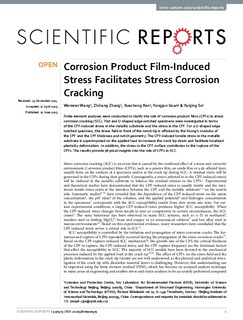| dc.contributor.author | Wang, Wenwen | |
| dc.contributor.author | Zhang, Zhiliang | |
| dc.contributor.author | Ren, Xuechong | |
| dc.contributor.author | Guan, Yongjun | |
| dc.contributor.author | Su, Yanjing | |
| dc.date.accessioned | 2015-09-25T12:12:54Z | |
| dc.date.accessioned | 2015-10-05T08:26:15Z | |
| dc.date.available | 2015-09-25T12:12:54Z | |
| dc.date.available | 2015-10-05T08:26:15Z | |
| dc.date.issued | 2015 | |
| dc.identifier.citation | Scientific Reports 2015, 5 | nb_NO |
| dc.identifier.issn | 2045-2322 | |
| dc.identifier.uri | http://hdl.handle.net/11250/2178753 | |
| dc.description.abstract | Finite element analyses were conducted to clarify the role of corrosion product films (CPFs) in stress corrosion cracking (SCC). Flat and U-shaped edge-notched specimens were investigated in terms of the CPF-induced stress in the metallic substrate and the stress in the CPF. For a U-shaped edge-notched specimen, the stress field in front of the notch tip is affected by the Young’s modulus of the CPF and the CPF thickness and notch geometry. The CPF-induced tensile stress in the metallic substrate is superimposed on the applied load to increase the crack tip strain and facilitate localized plasticity deformation. In addition, the stress in the CPF surface contributes to the rupture of the CPFs. The results provide physical insights into the role of CPFs in SCC. | nb_NO |
| dc.language.iso | eng | nb_NO |
| dc.publisher | Nature Publishing Group | nb_NO |
| dc.title | Corrosion product film-induced stress facilitates stress corrosion cracking | nb_NO |
| dc.type | Journal article | nb_NO |
| dc.type | Peer reviewed | en_GB |
| dc.date.updated | 2015-09-25T12:12:54Z | |
| dc.source.volume | 5 | nb_NO |
| dc.source.journal | Scientific Reports | nb_NO |
| dc.identifier.doi | 10.1038/srep10579 | |
| dc.identifier.cristin | 1258245 | |
| dc.description.localcode | Open access article. Creative Commons Attribution License 4.0. | nb_NO |
